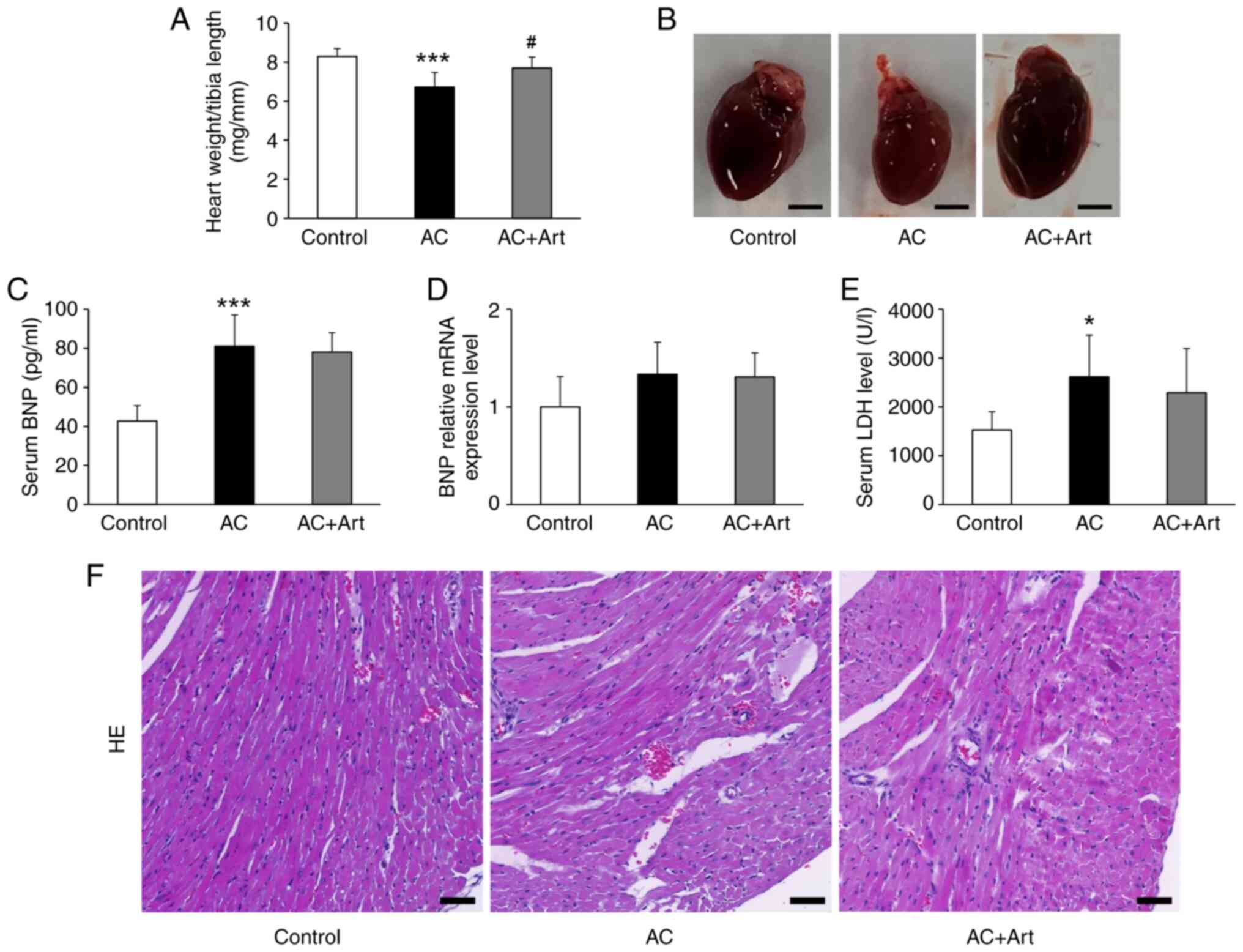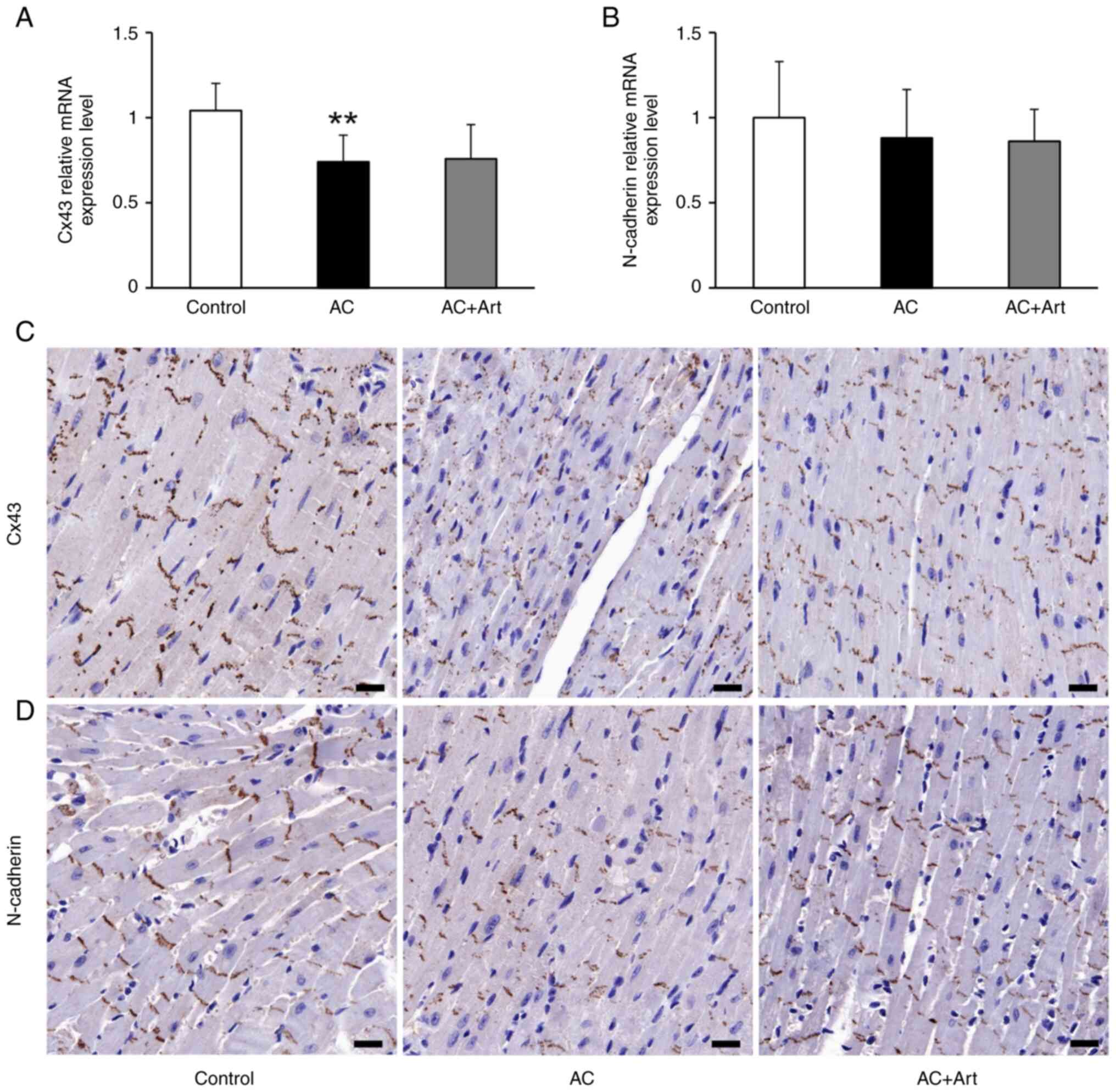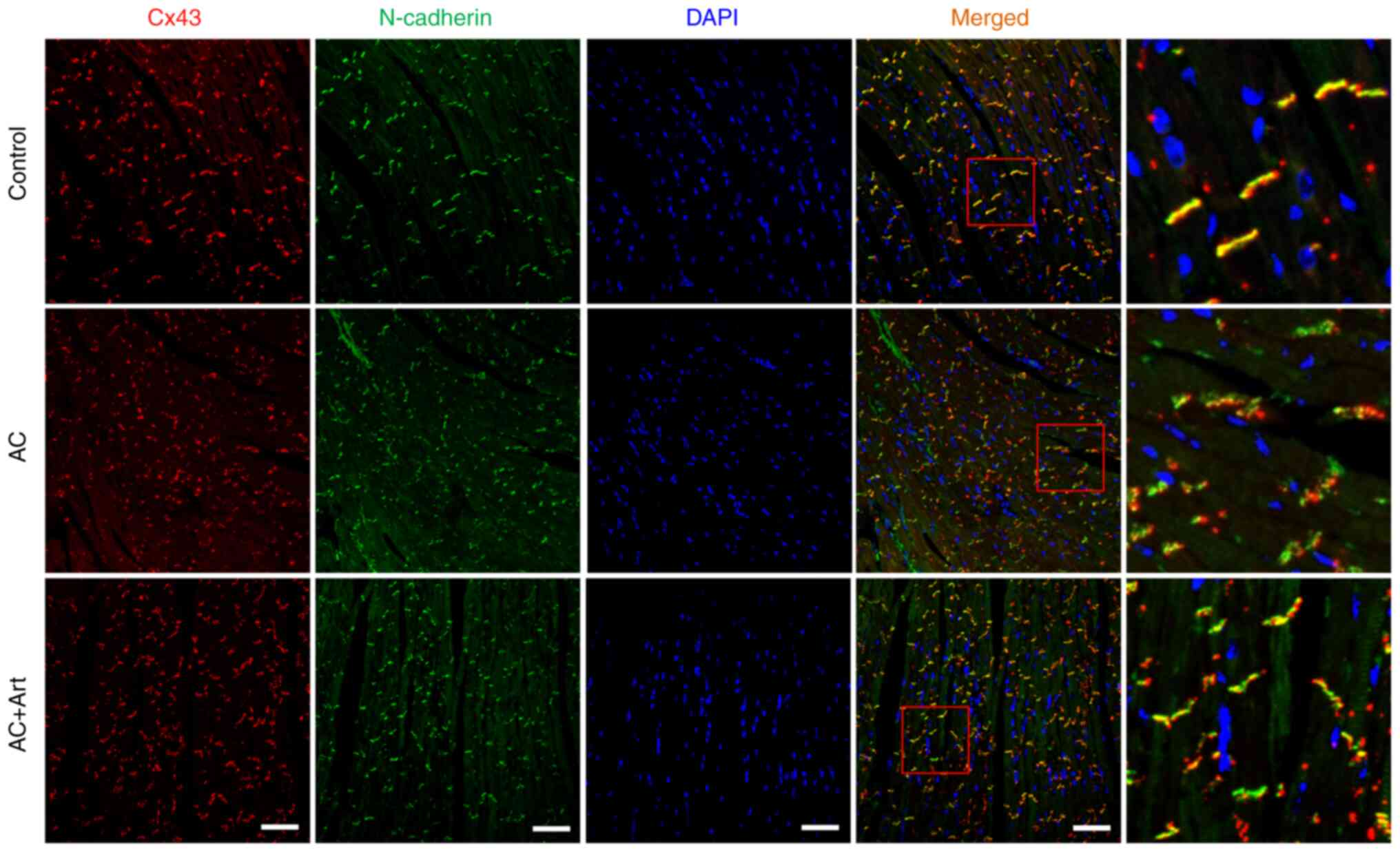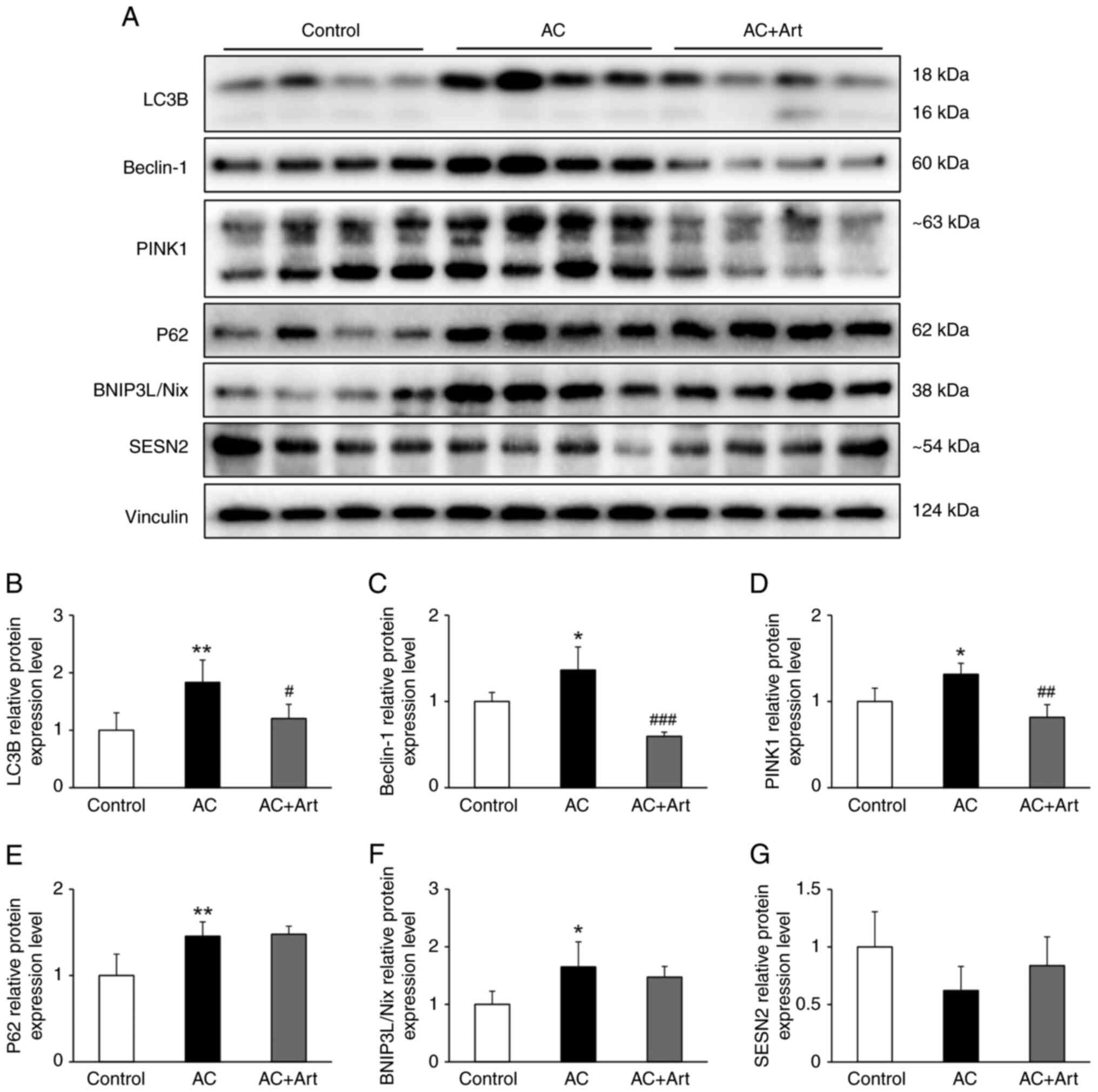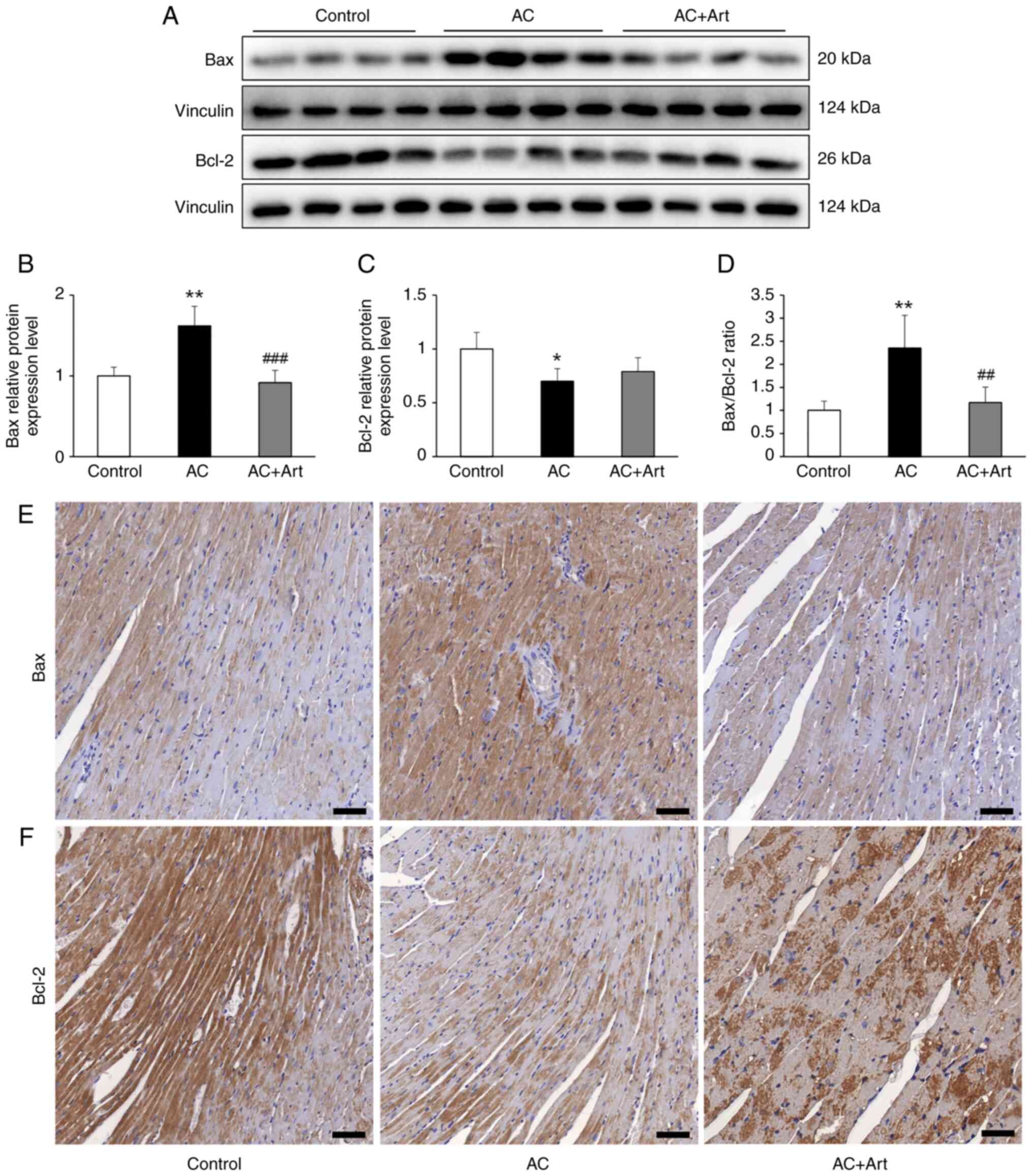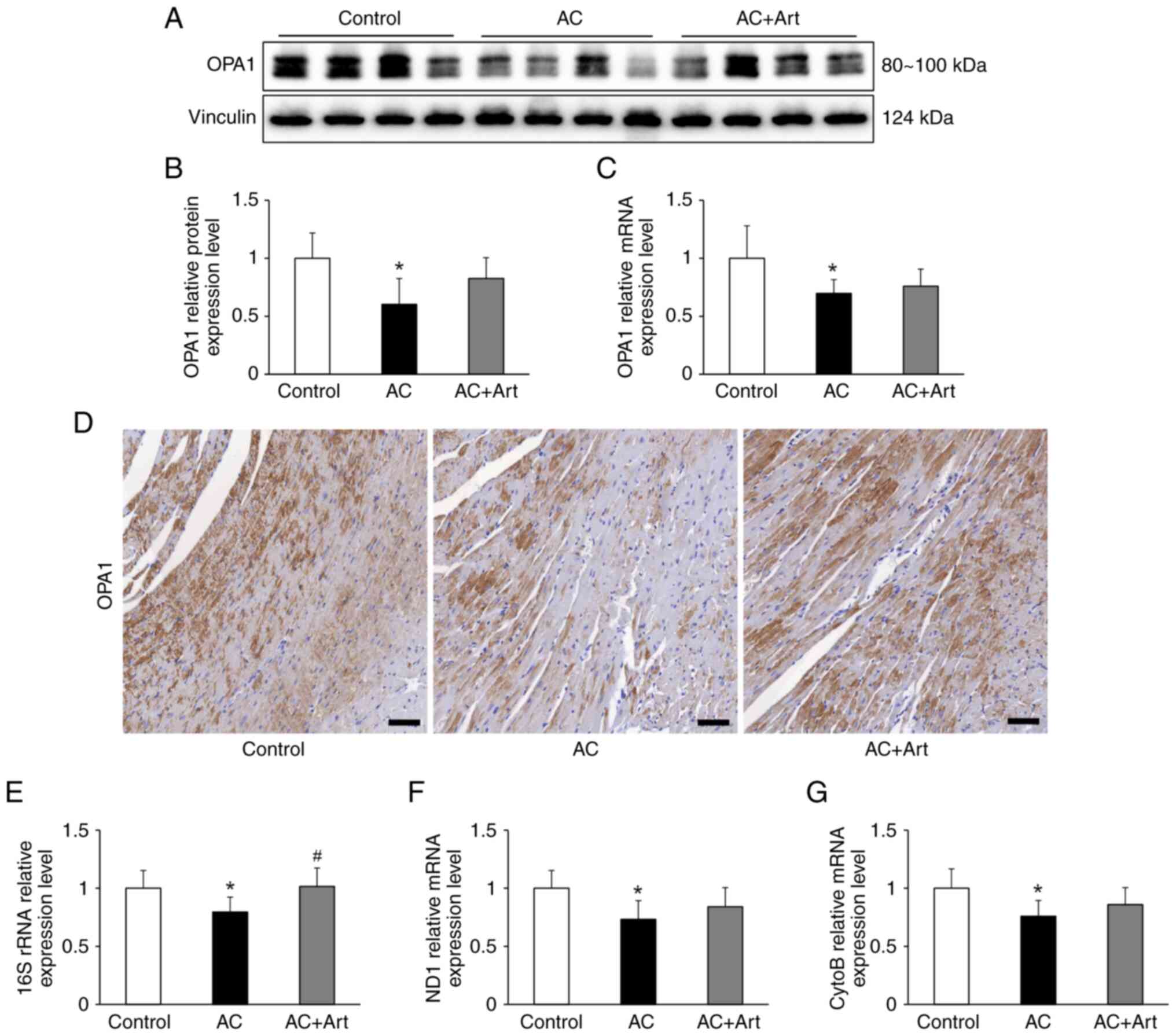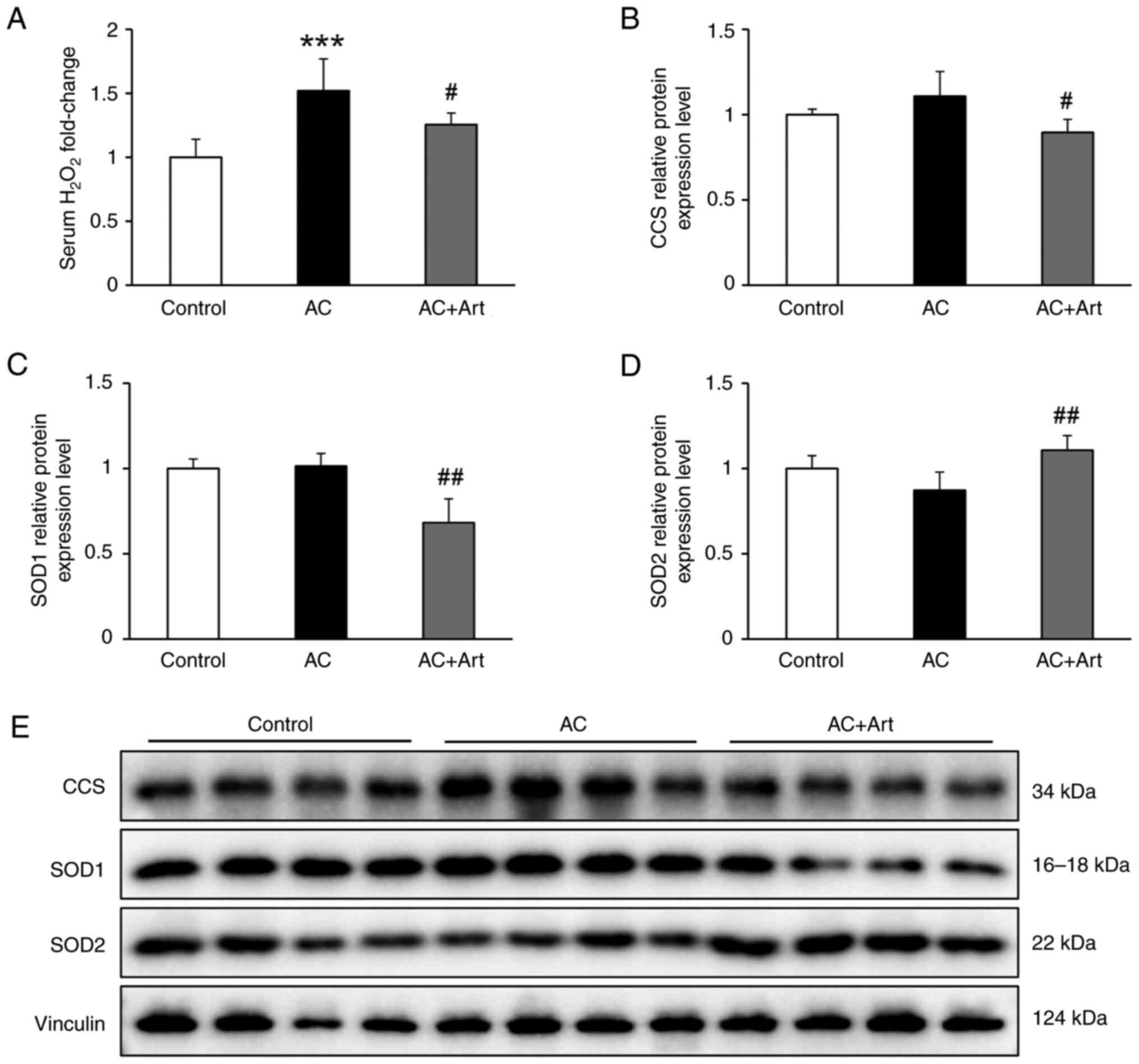Artemether ameliorates adriamycin induced cardiac atrophy in mice
- Authors:
- Published online on: June 23, 2023 https://doi.org/10.3892/mmr.2023.13040
- Article Number: 153
-
Copyright: © Weng et al. This is an open access article distributed under the terms of Creative Commons Attribution License.
Abstract
Introduction
Adriamycin is an anthracycline antitumor drug that has been widely used in the therapy of various tumors including breast cancer, bladder cancer, lymphoma, and acute lymphocytic leukemia. Although its clinical therapeutic efficacy is well established, its use is limited owing to various side effects, including irreversible cardiotoxicity (1). Exploring the pathophysiological process and developing novel therapeutic agents to antagonize the toxic effect of Adriamycin is necessary for tumor treatment, along with the prevention of heart disease.
Adriamycin inhibits DNA and RNA biosynthesis via DNA intercalation, further inducing a series of cytotoxic reactions (2). Mitochondrial dysfunction, redox imbalance, apoptosis, dysregulation of autophagy and the inflammatory response are involved in the pathophysiological process of Adriamycin organ damage (3); however, not all tissues and organs respond to Adriamycin in the same way and they may display varying degrees of lesions (4). Adriamycin cardiotoxicity is characterized by cardiomyocyte cell death through necrosis or apoptosis (5), and previous studies have suggested that cardiomyocyte atrophy is central to the pathogenesis of Adriamycin-induced cardiotoxicity (6,7). This process is largely attributed to the dysregulation of autophagy and the ubiquitin-proteasome system (8,9). Despite extensive studies, the initial mechanisms leading to the progression of Adriamycin-induced cardiotoxicity remain unclear.
Artemisinin is extracted from a well-known Chinese medicinal herb Artemisia annua L., also known as qinghao (10). Artemether is a derivative of artemisinin and is a commonly administered antimalarial drug (11). Artemisinin-based drugs possess remarkable biological activities, such as antifungal, antibacterial, anti-HIV, anticancer and antidiabetic properties (12,13). Previous studies by the authors have indicated that the therapeutic mechanisms of artemether are closely related to the regulation of mitochondrial function and redox status (14–18). Cardiomyocytes are rich in mitochondria and redox imbalance plays an important role in Adriamycin-induced cardiotoxicity (19); therefore, the present study aimed to explore the therapeutic effect of artemether on Adriamycin cardiotoxicity and investigate the underlying mechanisms.
Materials and methods
Animals and Adriamycin cardiotoxicity model
Male BALB/c mice (20–25 g, 8 weeks old, n=24, the success rate of mouse modeling was about 80%) were purchased from the Laboratory Animal Center of Southern Medical University (Guangzhou, China) and housed at room temperature 20–23°C, 12 h light/dark cycle, relative humidity 50–60%. All mice had free access to water and food. An Adriamycin cardiotoxicity mouse model was established by a single injection of Adriamycin (10.4 mg/kg; MilliporeSigma) through the tail vein. Adriamycin was dissolved in normal saline with a final concentration ~1.74 mg/ml. The total injection volume was about 120–150 µl for a dose of 10.4 mg/kg. After 2 weeks, the mice were randomly divided into the Adriamycin cardiotoxicity (AC) and AC + artemether (AC + Art) groups. Normal control group mice (mice that were not administered Adriamycin) were injected with an equal volume of saline solution. Control and AC group mice were fed a regular standard diet. Mice in the AC + Art group were fed a medicated diet containing 0.3 g/kg artemether (Chengdu ConBon Bio-tech Co., Ltd.). The intervention time lasted for 2 weeks. Animal studies were approved (approval no. 20200331002) and performed under the guidelines of The Institutional Animal Care and Use Committee at Guangzhou University of Chinese Medicine (Guangzhou, China).
Tissue preparation
At the end of treatment, the mice (18–29 g) were anesthetized with isoflurane (~3% for anesthetic induction and 1–2% for anesthetic maintenance), before drawing blood (~400 µl) from the orbital sinus vein. Afterwards, the mice were euthanized by cervical dislocation. Mouse death was verified by cessation of heartbeat, respiratory arrest and pupil dilation. The heart tissues were then isolated and weighed. Considering that tibial length is a more reliable reference for assessing organ changes when body weight fluctuates (20). The tibia length (left and right) was measured using a vernier caliper and heart weight/tibia length (average of left and right) was calculated. Sections of the heart tissues (4 µm) were fixed in 10% formalin (at room temperature for 48 h) for pathological examination and immunohistochemical staining. The remaining tissues were immediately frozen in liquid nitrogen and stored at −80°C for future analysis. Paraffin sections of the heart tissues were stained with hematoxylin and eosin (H&E) at room temperature (1 min for hematoxylin and 2 min for eosin) to observe the pathological changes. The serum lactate dehydrogenase (LDH) level was determined by using an automatic biochemical analyzer (Roche Diagnostics).
Immunohistochemical staining
Immunohistochemical staining was performed as previously described (16). Briefly, cardiac sections were deparaffinized using two sequential 5 min washes in fresh xylene and rehydrated in a descending ethanol series. After antigen retrieval using citrate buffer, the sections were incubated overnight at 4°C with primary antibodies against connexin 43 (Cx43, 1:100; cat. no. 3512), N-cadherin (1:100; cat. no. 14215), Bax (1:100; cat. no. 2772; all from Cell Signaling Technology, Inc.), Bcl-2 (1:100; cat. no. SAB4500003; Sigma-Aldrich; Merck KGaA) and Optic Atrophy 1 (OPA1, 1:100; cat. no. 612606; BD Biosciences). The sections were then washed and incubated at room temperature with ready-to-use horseradish peroxidase-conjugated secondary antibodies without dilution for 15 min (cat. no. KIT-5020; Fuzhou MaiXin Biotech Co, Ltd.). The chromogenic reagent used was 3,3′-diaminobenzidine, and the sections were counterstained using hematoxylin.
Immunofluorescent staining
After incubation with Cx43 (1:50) and N-cadherin (1:50) primary antibodies, Alexa Fluor-conjugated secondary antibodies (1:500; Invitrogen; Thermo Fisher Scientific, Inc; cat. no. A-11037; Goat anti-Rabbit Secondary Antibody, Alexa Fluor™ 594; and cat. no. A-11029; Goat anti-Mouse Secondary Antibody, Alexa Fluor™ 488) were incubated for 1 h at room temperature. The tissues were visualized and images were captured using a confocal microscope (LSM710; Carl Zeiss AG).
Enzyme-linked immunosorbent assay
Serum B-type natriuretic peptide (BNP) levels were determined using an enzyme-linked immunosorbent assay (cat. no. SEKM-0151; Beijing Solarbio Science & Technology Co., Ltd.), according to the manufacturer's instructions.
Serum H2O2 determination
Serum H2O2 levels were detected using Amplex UltraRed reagent (cat. no. A36006; Invitrogen; Thermo Fisher Scientific, Inc.), according to the manufacturer's protocol.
Immunoblot analysis
Heart tissues were homogenized and prepared in sample loading buffer (cat. no. 1610747, Bio-Rad Laboratories, Inc.). The protein concentrations were determined using Bradford Dye Reagent (cat. no. 500-0205, Bio-Rad Laboratories, Inc.). The same mass of protein (~15 µl/45 ug) was loaded per lane. The homogenates were separated using sodium dodecyl sulfate-polyacrylamide gel (10%) electrophoresis and subsequently electro-transferred to polyvinylidene fluoride membranes (MilliporeSigma). After blocking in 5% non-fat milk for 1 h at room temperature, the membranes were incubated overnight at 4°C with the following primary antibodies: LC3B (1:500; cat. no. L7543; Sigma-Aldrich; Merck KGaA), Beclin-1 (1:500; cat. no. 3495; Cell Signaling Technology, Inc.), PTEN-induced kinase 1 (PINK1; 1:500; cat. no. GTX59847; GeneTex, Inc.), p62 (1:500; cat. no. 18420; Proteintech Group, Inc.), BNIP3L/Nix (1:500; cat. no. 12396; Cell Signaling Technology, Inc.), Sestrin2 (SESN2; 1:500; cat. no. GTX64418; GeneTex, Inc.), Bax (1:500; cat. no. 2772; Cell Signaling Technology, Inc.), Bcl-2 (1:500; cat. no. SAB4500003; Sigma-Aldrich; Merck KGaA), OPA1 (1:500; cat. no. 612606; BD Biosciences), copper chaperone for superoxide dismutase (CCS; 1:500; cat. no. 22802; Proteintech Group, Inc.), superoxide dismutase 1 (SOD1; 1:500; cat. no. 37385), SOD2 (1:1,000; cat. no. 13141) and Vinculin (1:500; cat. no. 13901; all from Cell Signaling Technology, Inc.). After incubating with the corresponding horseradish peroxidase-conjugated secondary antibodies (1:2,000; cat. nos. 65-6120 or 62-6520; Invitrogen; Thermo Fisher Scientific, Inc.) at room temperature for 1 h, the images were obtained using a ChemiDoc Imaging System (Bio-Rad Laboratories, Inc.) and analyzed using ImageJ software (Version 1.8.0; National Institutes of Health).
Reverse transcription-quantitative (RT-q)PCR
Total RNA from the heart tissues was purified using an RNA purification kit (cat. no. 12183025; Invitrogen; Thermo Fisher Scientific, Inc.). The first-strand cDNA was synthesized using oligo(dT)12-18 primers (cat. no. 18418012; Invitrogen; Thermo Fisher Scientific, Inc.), dNTP Mix (cat. no. 18427-013; Invitrogen), Ribonuclease Inhibitor (cat. no. 10777-019; Invitrogen), DTT (cat. no. Y00147; Invitrogen), and M-MLV Reverse Transcriptase (cat. no. 28025-013; Invitrogen). The reaction process was under 37°C for 50 min and then was terminated at 70°C for 15 min. qPCR was performed using SYBR green PCR master mix (cat. no. 4367659; Applied Biosystems; Thermo Fisher Scientific, Inc.) using the Applied Biosystems QuantStudio 5 platform and the amplification conditions (95°C for 5 min followed by 45 cycles of 95°C for 15 s, 55°C for 15 s and 72°C for 20 s) were set as previously described (16). Gene specific primers (Table I) were provided by Sangon Biotech Co., Ltd. The relative RNA expression levels were calculated using 2−ΔΔCq (21) and normalized against the housekeeping gene, 18S rRNA.
Statistical analysis
Data are presented as the mean ± standard deviation. One-way analysis of variance followed by least significant difference post hoc test was used for data analysis using SPSS software (Version 22.0; IBM Corp.). P<0.05 was considered to indicate a statistically significant difference.
Results
Artemether prevents Adriamycin-induced cardiac atrophy
As shown in Fig. 1A and B, a significant decrease in heart weight/tibia length was observed in the AC group, and artemether treatment notably prevented cardiac atrophy. Compared with the control group, the AC group had significantly increased serum BNP and LDH levels (Fig. 1C and E). Although BNP mRNA expression in the heart tissue was also upregulated in the AC group, the difference was not significant (Fig. 1D). Artemether therapy did not affect BNP expression and secretion in the heart after Adriamycin exposure (Fig. 1C and D). The serum level of LDH was slightly reduced by artemether but not to significant degree (Fig. 1E). H&E staining revealed loosening or disruption of myocardial fibers in the AC group, and these pathological changes were attenuated by artemether therapy (Fig. 1F).
Artemether stabilizes the intercellular junctions between ventricular myocytes
Cx43 and N-cadherin are the main constituents of the gap and adherens junctions, respectively, in the myocardium (22). They form the structural basis for the synchronous coordination of myocardial fibers, which are essential for maintaining cardiac function (23). Compared with the control group, the AC group had a significant decrease in Cx43 mRNA expression (Fig. 2A). Immunohistochemical staining demonstrated that Cx43 and N-cadherin were preferentially distributed in intercalated discs (Fig. 2C and D). As shown in Fig. 3, diminished colocalization of Cx43 and N-cadherin was observed at the intercalated discs in the AC group. Although artemether treatment did not affect the expression of Cx43 and N-cadherin (Fig. 2A and B), it notably restored and stabilized their intercombination (Figs. 2C and D and 3).
Artemether regulates myocardial cell autophagy
Autophagy is a cellular protein degradation pathway, which plays an important role in cardiac dysfunction and atrophy (24). In the present study, significantly increased LC3B, Beclin-1, p62, BNIP3L/Nix and PINK1 protein levels were detected in the AC group, which indicated an activation of autophagy following Adriamycin exposure (Fig. 4A-F). A marginal and insignificant decline in SESN2 was observed in the AC group (Fig. 4A and G). After treatment with artemether, the levels of LC3B, Beclin-1 and PINK1 were significantly decreased, while the levels of p62 and BNIP3L/Nix were unchanged; a marginal and insignificant increase in the level of SESN2 was also observed (Fig. 4A-G).
Artemether restores the unbalanced ratio of Bax and Bcl-2 in myocardial cells
The Bax/Bcl-2 ratio is closely related to mitochondrial function and the autophagy pathway (25,26); therefore, Bax and Bcl-2 protein levels in heart tissue were measured in the present study. As revealed in Fig. 5A-D, significantly increased Bax, decreased Bcl-2 and an abnormally elevated Bax/Bcl-2 ratio was observed in the AC group, compared with the control group. Although artemether treatment did not significantly increase the Bcl-2 protein levels, it did significantly decrease the Bax levels and the Bax/Bcl-2 ratio (Fig. 5A-D). As indicated by immunohistochemical analysis, Bax and Bcl-2 were primarily located in the myocardial cells and the expression levels were in line with the immunoblotting results (Fig. 5E and F).
Artemether affects the levels of mitochondria constituents in myocardial cells
OPA1 is essential for mitochondrial cristae formation and its loss disrupts the mitochondrial inner membrane structure and integrity, leading to mitochondrial dysfunction (27). After Adriamycin exposure, an expected decrease in the protein and mRNA levels of OPA1 were observed in the myocardial cell, and these levels insignificantly increased upon treatment with artemether (Fig. 6A-D). The mitochondrial DNA (mtDNA) encoded mitochondrial constituents, including 16S rRNA, NADH dehydrogenase 1 (ND1) and cytochrome b (CytoB), were significantly decreased in the AC group (Fig. 6E-G). The level of 16S rRNA was significantly increased by artemether treatment, and the ND1 and CytoB mRNA levels were also increased by artemether, but the difference was not significant (Fig. 6E-G).
Artemether ameliorates cardiac redox imbalance
Mitochondria are the main source of reactive oxygen species (ROS), and its dysfunction is the primary cause of redox imbalance in the body (28). Compared with the control group, the AC groups exhibited significantly elevated serum H2O2 levels, which were significantly decreased by artemether treatment (Fig. 7A). As demonstrated in Fig. 7B-E, slightly increased CCS, decreased SOD2 and unaltered SOD1 levels were detected in the AC group, compared with the control group. After artemether therapy, CCS and SOD1 levels were significantly decreased, and SOD2 levels were significantly increased (Fig. 7B-E).
Discussion
In the present study, it was demonstrated that artemether ameliorated Adriamycin-induced cardiac atrophy and the mechanisms may be associated with regulating mitochondrial function and autophagy.
Consistent with previous studies (9,29), in the present study it was demonstrated that cardiac atrophy occurred 4 weeks after Adriamycin injection. Significantly elevated serum BNP levels and pathological alterations also reflected cardiac dysfunction resulting from Adriamycin exposure. Artemether treatment prevented cardiac atrophy and attenuated pathological lesions; however, it did not affect BNP expression. BNP is produced primarily by cardiac ventricular myocytes in response to altered ventricular wall stress. Subsequently, it is secreted into the blood and exerts a wide range of biological effects, including diuresis, natriuresis, vasodilation, and smooth muscle relaxation (30); therefore, it was hypothesized that elevated serum BNP may be a compensatory response to cardiac dysfunction. The integrity of cell membrane structure and intercellular connections is essential for maintaining cell function (31). Cardiac intercalated discs are highly specialized structures that play a key role in the coordination and synchronization of myocardial contraction (22). In the present study, in addition to the expected pathological alterations, such as myocardial fiber disruption and cardiomyocyte interstitium widening, the cardiac intercalated discs were also destroyed, which manifested as decreased Cx43 expression and abnormal colocalization of Cx43 and N-cadherin, although there was no significant difference in N-cadherin mRNA levels between the control and AC groups; however, N-cadherin immunohistochemical staining appeared to be lower in the AC group than the control group. It was hypothesized that this inconsistency suggests that N-cadherin may be regulated at both the transcriptional and translational levels. Artemether intervention did not affect Cx43 and N-cadherin mRNA expression levels; however, it notably recovered and stabilized their intercombination.
Cardiomyocyte atrophy, rather than cell death, is the primary determinant of the subacute decrease in heart weight after Adriamycin exposure (6,9). To explore the pathophysiological mechanism of myocardial atrophy in the present study, autophagy pathway-associated proteins in the myocardial tissue were analyzed. The results suggested that autophagy-related protein degradation occurred in the cardiomyocytes, and artemether treatment markedly regulated the pathway. As a major pathway responsible for the recycling of intracellular substances, autophagy can be activated by a variety of stress stimuli, including mitochondrial dysfunction (32). Bax and Bcl-2 belong to the Bcl-2 protein family, which regulates cell autophagy, mitochondrial bioenergetic metabolism and redox homeostasis; their biological effect occurs by translocation between the cytoplasm and the outer mitochondrial membrane (25,26). In the present study, the AC group had a significantly increased Bax/Bcl-2 ratio, indicating compromised mitochondria in the myocardial cell. OPA1 is an inner mitochondrial membrane protein that helps to regulate mitochondrial fusion and cristae morphology (27). In the present study, significantly decreased OPA1 protein and mRNA levels also indicated dysfunctional mitochondria in the myocardial cell. In addition, the mtDNA encoded 16S rRNA, ND1 and CytoB were all decreased in the AC group. Collectively, this evidence indicated that Adriamycin exposure induced mitochondrial damage and activated the cellular autophagy pathway. These mitochondrial alterations improved to varying degrees by artemether treatment in the present study. It has been reported that Adriamycin-induced cardiac atrophy is mediated by the striated muscle-specific ubiquitin ligase, muscle ring-finger protein-1, and activation of the ubiquitin-proteasome system is associated with ROS production (9,33); therefore, it was hypothesized that the ubiquitin-proteasome system may also be the therapeutic target of artemether, however, this needs further investigation.
Mitochondria are the principal generators of cellular superoxide radicals. Considering that the myocardial cell is rich in mitochondria, it is reasonable to hypothesize that the significantly elevated serum H2O2 levels observed in the present study are, at least partly, due to damaged mitochondria in the heart. SOD2 and SOD1 are mitochondrial and cytoplasmic superoxide free radical scavenging systems, respectively (34). CCS is a critical component of the redox system and is located in the cytosol and intermembrane space of mitochondria (35). The loss of SOD2 correlates with the overexpression of SOD1 and their mutual transformation is closely associated with cellular redox imbalance and tumorigenesis (36,37). Although Adriamycin did not significantly alter their protein levels in the present study, the SOD1/SOD2 ratio was altered to some extent; therefore, treatment with artemether remodeled the intracellular antioxidant system.
In summary, the present study demonstrated that artemether prevented Adriamycin-induced cardiac atrophy by regulating mitochondrial function and the autophagy pathway. These findings have potential clinical implications for preventing heart disease or cardiotoxicity induced by chemotherapy drugs.
Acknowledgements
Not applicable.
Funding
The present study was supported by the National Natural Science Foundation of China (grant no. 82004156), the Shenzhen Science and Technology Project (grant no. JCYJ20190812183603627) and the Shenzhen Fund for Guangdong Provincial High level Clinical Key Specialties.
Availability of data and materials
The datasets used and/or analyzed during the current study are available from the corresponding author on reasonable request.
Authors' contributions
PH and HS proposed the conception and original design of the present study. WW performed the majority of the experiments and analyzed most of the data. XY participated in animal tissue processing and sectioning. YD performed some of the immunoblotting experiments. TW participated in the animal experiments. MS contributed to some of the pathological experiments. PH and WW wrote the manuscript. PH and HS confirm the authenticity of all the raw data. All authors read and approved the final version of the manuscript.
Ethics approval and consent to participate
All animal procedures were approved (approval no. 20200331002) by the Animal Care and Use Committee of Guangzhou University of Chinese Medicine (Guangzhou, China).
Patient consent for publication
Not applicable.
Competing interests
The authors declare that they have no competing interests.
References
|
van der Zanden SY, Qiao X and Neefjes J: New insights into the activities and toxicities of the old anticancer drug doxorubicin. FEBS J. 288:6095–6111. 2021. View Article : Google Scholar : PubMed/NCBI | |
|
Tacar O, Sriamornsak P and Dass CR: Doxorubicin: An update on anticancer molecular action, toxicity and novel drug delivery systems. J Pharm Pharmacol. 65:157–170. 2013. View Article : Google Scholar : PubMed/NCBI | |
|
Sritharan S and Sivalingam N: A comprehensive review on time-tested anticancer drug doxorubicin. Life Sci. 278:1195272021. View Article : Google Scholar : PubMed/NCBI | |
|
Pugazhendhi A, Edison TNJI, Velmurugan BK, Jacob JA and Karuppusamy I: Toxicity of Doxorubicin (Dox) to different experimental organ systems. Life Sci. 200:26–30. 2018. View Article : Google Scholar : PubMed/NCBI | |
|
Christidi E and Brunham LR: Regulated cell death pathways in doxorubicin-induced cardiotoxicity. Cell Death Dis. 12:3392021. View Article : Google Scholar : PubMed/NCBI | |
|
Chen DS, Yan J and Yang PZ: Cardiomyocyte Atrophy, an Underestimated Contributor in Doxorubicin-Induced Cardiotoxicity. Front Cardiovasc Med. 9:8125782022. View Article : Google Scholar : PubMed/NCBI | |
|
Ferreira de Souza T, Quinaglia AC, Silva T, Osorio Costa F, Shah R, Neilan TG, Velloso L, Nadruz W, Brenelli F, Sposito AC, Matos-Souza JR, et al: Anthracycline therapy is associated with cardiomyocyte atrophy and preclinical manifestations of heart disease. JACC Cardiovasc Imaging. 11:1045–1055. 2018. View Article : Google Scholar : PubMed/NCBI | |
|
Bartlett JJ, Trivedi PC and Pulinilkunnil T: Autophagic dysregulation in doxorubicin cardiomyopathy. J Mol Cell Cardiol. 104:1–8. 2017. View Article : Google Scholar : PubMed/NCBI | |
|
Willis MS, Parry TL, Brown DI, Mota RI, Huang W, Beak JY, Sola M, Zhou C, Hicks ST, Caughey MC, et al: Doxorubicin exposure causes subacute cardiac atrophy dependent on the striated muscle-specific ubiquitin ligase MuRF1. Circ Heart Fail. 12:e0052342019. View Article : Google Scholar : PubMed/NCBI | |
|
Ma N, Zhang Z, Liao F, Jiang T and Tu Y: The birth of artemisinin. Pharmacol Ther. 216:1076582020. View Article : Google Scholar : PubMed/NCBI | |
|
Esu EB, Effa EE, Opie ON and Meremikwu MM: Artemether for severe malaria. Cochrane Database Syst Rev. 6:CD0106782019.PubMed/NCBI | |
|
Wang Y, Wang Y, You F and Xue J: Novel use for old drugs: The emerging role of artemisinin and its derivatives in fibrosis. Pharmacol Res. 157:1048292020. View Article : Google Scholar : PubMed/NCBI | |
|
Dolivo D, Weathers P and Dominko T: Artemisinin and artemisinin derivatives as anti-fibrotic therapeutics. Acta Pharm Sin B. 11:322–339. 2021. View Article : Google Scholar : PubMed/NCBI | |
|
Han P, Wang Y, Zhan H, Weng W, Yu X, Ge N, Wang W, Song G, Yi T, Li S, et al: Artemether ameliorates type 2 diabetic kidney disease by increasing mitochondrial pyruvate carrier content in db/db mice. Am J Transl Res. 11:1389–1402. 2019.PubMed/NCBI | |
|
Wang Y, Han P, Wang M, Weng W, Zhan H, Yu X, Yuan C, Shao M and Sun H: Artemether improves type 1 diabetic kidney disease by regulating mitochondrial function. Am J Transl Res. 11:3879–3889. 2019.PubMed/NCBI | |
|
Han P, Cai Y, Wang Y, Weng W, Chen Y, Wang M, Zhan H, Yu X, Wang T, Shao M and Sun H: Artemether ameliorates kidney injury by restoring redox imbalance and improving mitochondrial function in Adriamycin nephropathy in mice. Sci Rep. 11:12662021. View Article : Google Scholar : PubMed/NCBI | |
|
Cheng X, Zhou P, Weng W, Sun Z, Liu H, Chen Y, Cai Y, Yu X, Wang T, Shao M, et al: Artemether attenuates renal tubular injury by targeting mitochondria in adriamycin nephropathy mice. Am J Transl Res. 14:2002–2012. 2022.PubMed/NCBI | |
|
Weng W, Liu H, Sun Z, Zhou P, Yu X, Shao M, Han P and Sun H: Combined treatment with niclosamide ethanolamine and artemether combination improves type 1 diabetes via the targeting of liver mitochondria. Exp Ther Med. 23:2392022. View Article : Google Scholar : PubMed/NCBI | |
|
Wallace KB, Sardao VA and Oliveira PJ: Mitochondrial determinants of doxorubicin-induced cardiomyopathy. Circ Res. 126:926–941. 2020. View Article : Google Scholar : PubMed/NCBI | |
|
Yin FC, Spurgeon HA, Rakusan K, Weisfeldt ML and Lakatta EG: Use of tibial length to quantify cardiac hypertrophy: Application in the aging rat. Am J Physiol. 243:H941–H947. 1982.PubMed/NCBI | |
|
Livak KJ and Schmittgen TD: Analysis of relative gene expression data using real-time quantitative PCR and the 2(−Delta Delta C(T)) Method. Methods. 25:402–408. 2001. View Article : Google Scholar : PubMed/NCBI | |
|
Zhao G, Qiu Y, Zhang HM and Yang D: Intercalated discs: Cellular adhesion and signaling in heart health and diseases. Heart Fail Rev. 24:115–132. 2019. View Article : Google Scholar : PubMed/NCBI | |
|
Leo-Macias A, Agullo-Pascual E and Delmar M: The cardiac connexome: Non-canonical functions of connexin43 and their role in cardiac arrhythmias. Semin Cell Dev Biol. 50:13–21. 2016. View Article : Google Scholar : PubMed/NCBI | |
|
Orogo AM and Gustafsson AB: Therapeutic targeting of autophagy: Potential and concerns in treating cardiovascular disease. Circ Res. 116:489–503. 2015. View Article : Google Scholar : PubMed/NCBI | |
|
Gross A and Katz SG: Non-apoptotic functions of BCL-2 family proteins. Cell Death Differ. 24:1348–1358. 2017. View Article : Google Scholar : PubMed/NCBI | |
|
Chong SJF, Marchi S, Petroni G, Kroemer G, Galluzzi L and Pervaiz S: Noncanonical cell fate regulation by Bcl-2 Proteins. Trends Cell Biol. 30:537–555. 2020. View Article : Google Scholar : PubMed/NCBI | |
|
Jang S and Javadov S: OPA1 regulates respiratory supercomplexes assembly: The role of mitochondrial swelling. Mitochondrion. 51:30–39. 2020. View Article : Google Scholar : PubMed/NCBI | |
|
Dan Dunn J, Alvarez LA, Zhang X and Soldati T: Reactive oxygen species and mitochondria: A nexus of cellular homeostasis. Redox Biol. 6:472–485. 2015. View Article : Google Scholar : PubMed/NCBI | |
|
Shimauchi T, Numaga-Tomita T, Ito T, Nishimura A, Matsukane R, Oda S, Hoka S, Ide T, Koitabashi N, Uchida K, et al: TRPC3-Nox2 complex mediates doxorubicin-induced myocardial atrophy. JCI Insight. 2:e933582017. View Article : Google Scholar : PubMed/NCBI | |
|
Nash PL: Brain type natriuretic peptide. Neonatal Netw. 27:343–346. 2008. View Article : Google Scholar : PubMed/NCBI | |
|
Belardi B, Son S, Felce JH, Dustin ML and Fletcher DA: Cell-cell interfaces as specialized compartments directing cell function. Nat Rev Mol Cell Biol. 21:750–764. 2020. View Article : Google Scholar : PubMed/NCBI | |
|
Dikic I and Elazar Z: Mechanism and medical implications of mammalian autophagy. Nat Rev Mol Cell Biol. 19:349–364. 2018. View Article : Google Scholar : PubMed/NCBI | |
|
Montalvo RN, Doerr V, Min K, Szeto HH and Smuder AJ: Doxorubicin-induced oxidative stress differentially regulates proteolytic signaling in cardiac and skeletal muscle. Am J Physiol Regul Integr Comp Physiol. 318:R227–R233. 2020. View Article : Google Scholar : PubMed/NCBI | |
|
Wang Y, Branicky R, Noe A and Hekimi S: Superoxide dismutases: Dual roles in controlling ROS damage and regulating ROS signaling. J Cell Biol. 217:1915–1928. 2018. View Article : Google Scholar : PubMed/NCBI | |
|
Boyd SD, Ullrich MS, Skopp A and Winkler DD: Copper Sources for Sod1 Activation. Antioxidants (Basel). 9:5002020. View Article : Google Scholar : PubMed/NCBI | |
|
Papa L, Hahn M, Marsh EL, Evans BS and Germain D: SOD2 to SOD1 switch in breast cancer. J Biol Chem. 289:5412–5416. 2014. View Article : Google Scholar : PubMed/NCBI | |
|
Chang YC, Fong Y, Tsai EM, Chang YG, Chou HL, Wu CY, Teng YN, Liu TC, Yuan SS and Chiu CC: Exogenous C8-Ceramide induces apoptosis by overproduction of ROS and the switch of superoxide dismutases SOD1 to SOD2 in human lung cancer cells. Int J Mol Sci. 19:30102018. View Article : Google Scholar : PubMed/NCBI |



